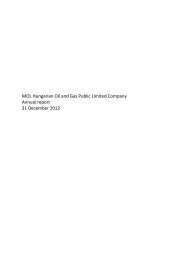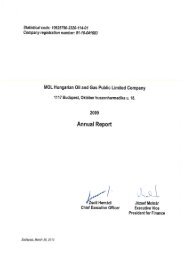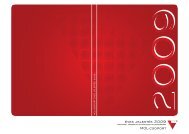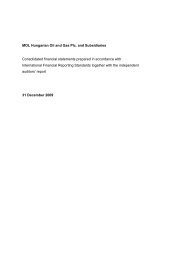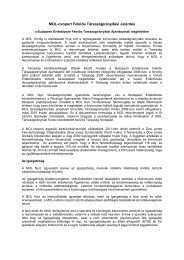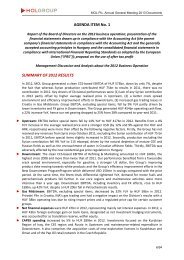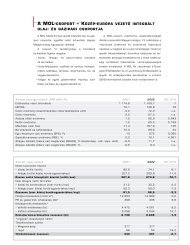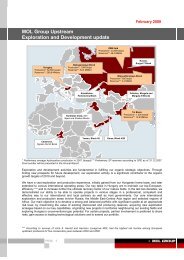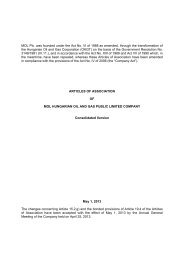off. Upon determination of economically recoverable reserves (‘proved reserves’ or ‘commercial reserves’), amortizationceases and the remaining costs are aggregated with exploration expenditure and held on a field-by-field basis as provedproperties awaiting approval within intangible assets. When development is approved internally, the relevant expenditure istransferred to property, plant and equipment, among land and buildings.Exploration expenditureGeological and geophysical exploration costs are charged against income as incurred. Costs directly associatedwith an exploration well are capitalized as an intangible asset until the drilling of the well is complete and theresults have been evaluated. These costs include employee remuneration, materials and fuel used, rig costs, delayrentals and payments made to contractors. If hydrocarbons are not found, the exploration expenditure is writtenoff as a dry hole. If hydrocarbons are found and, subject to further appraisal activity, which may include the drillingof further wells (exploration or exploratory-type stratigraphic test wells), are likely to be capable of commercialdevelopment, the costs continue to be carried as an asset. All such carried costs are subject to technical, commercialand management review at least once a year to confirm the continued intent to develop or otherwise extract valuefrom the discovery. When this is no longer the case, the costs are written off. When proved reserves of oil andnatural gas are determined and development is sanctioned, the relevant expenditure is transferred to property,plant and equipment.Provision for DecommissioningThe Group records a provision upon initial recognition for the present value of the estimated future cost of abandonmentof oil and gas production facilities following the termination of production. The estimate is based upon current legislativerequirements, technology and price levels. A corresponding item of property, plant and equipment of an amount equivalentto the provision is also created. This is subsequently depreciated as part of the capital costs of the facility or item of plant. Anychange in the present value of the estimated expenditure is reflected as an adjustment to the provision and the correspondingproperty, plant and equipment.Provision for Retirement BenefitsThe Group operates three long term defined employee benefit programmes. None of these schemes requirescontribution to be made to separately administered funds. The cost of providing benefits under those plans isdetermined separately for each plan using the projected unit credit actuarial valuation method. Actuarial gains andlosses are recognized as income or expense immediately. Past service costs, resulting from the introduction of, orchanges to the defined benefit scheme are recognized as an expense on a straight-line basis over the average perioduntil the benefits become vested.xviii) Greenhouse gas emissionsDevelopment expenditureExpenditure on the construction, installation or completion of infrastructure facilities such as platforms, and the drillingof development wells, including unsuccessful development or delineation wells, is capitalized within property, plant andequipment.xvi) Interest-bearing loans and borrowingsAll loans and borrowings are initially recognized at the fair value of the consideration received net of issue costs associatedwith the borrowing. After initial recognition, interest-bearing loans and borrowings are subsequently measured at amortisedcost using the effective interest method. Amortised cost is calculated by taking into account any issue costs, and anydiscount or premium on settlement. Gains and losses are recognized in net in the income statement when the liabilities arederecognized as well as through the amortisation process, except to the extent they are capitalized as borrowing costs.xvii) ProvisionsA provision is recognized when the Group has a present obligation (legal or constructive) as a result of a past event and itis probable (i.e. more likely than not) that an outflow of resources embodying economic benefits will be required to settlethe obligation, and a reliable estimate can be made of the amount of the obligation. When the Group expects some or allof the provision to be reimbursed; the reimbursement is recognised as a separate asset but only when the reimbursementis actually certain. Provisions are reviewed at each balance sheet date and adjusted to reflect the current best estimate.The amount of the provision is the present value of the risk adjusted expenditures expected to be required to settle theobligation, determined using the estimated risk free interest rate as discount rate. Where discounting is used, the carryingamount of the provisions increases in each period to reflect the unwinding of the discount by the passage of time. Thisincrease is recognized as interest expense.The Group receives free emission rights in Hungary and Slovakia as a result of the European Emission Trading Schemes.The rights are received on an annual basis and in return the Group is required to remit rights equal to its actual emissions.The Group has adopted a net liability approach to the emission rights granted. A provision is only recognized when actualemissions exceed the emission rights granted and still held. Where emission rights are purchased from other parties, they arerecorded at cost, and treated as a reimbursement right, whereby they are matched to the emission liabilities and remeasuredto fair value.xix) Share-based payment transactionsCertain employees (including directors and managers) of the Group receive remuneration in the form of share-based paymenttransactions, whereby employees render services in exchange for shares or rights over shares (‘equity-settled transactions’).Equity-settled transactionsThe cost of equity-settled transactions with employees is measured by reference to the fair value at the date at which theyare granted. The fair value is determined by applying generally accepted option pricing models (usually by the binomialmodel). In valuing equity-settled transactions, no account is taken of any performance conditions, other than conditionslinked to the price of the shares of the parent company (‘market conditions’).The cost of equity-settled transactions is recognized, together with a corresponding increase in equity, over the period inwhich the performance conditions are fulfilled, ending on the date on which the relevant employees become fully entitledto the award (‘vesting date’). The cumulative expense recognized for equity settled transactions at each reporting date untilthe vesting date reflects the extent to which the vesting period has expired and the number of awards that, in the opinion ofthe directors of the Group at that date, based on the best available estimate of the number of equity instruments that willultimately vest.Notes to the financialstatementsProvision for RedundancyThe employees of the Group are eligible, immediately upon termination, for redundancy payment pursuant to the Hungarianlaw and the terms of the Collective Agreement between <strong>MOL</strong> and its employees. The amount of such a liability is recordedas a provision in the consolidated balance sheet when the workforce reduction program is defined, announced and theconditions for its implementation are met.Provision for Environmental ExpendituresEnvironmental expenditures that relate to current or future economic benefits are expensed or capitalized as appropriate.Expenditures that relate to an existing condition caused by past operations and do not contribute to current or futureearnings are expensed. Liabilities for environmental costs are recognized when environmental assessments or clean-ups areprobable and the associated costs can be reasonably estimated. Generally, the timing of these provisions coincides with thecommitment to a formal plan of action or, if earlier, on divestment or on closure of inactive sites. The amount recognizedis the best estimate of the expenditure required. Where the liability will not be settled for a number of years, the amountrecognized is the present value of the estimated future expenditure.No expense is recognized for awards that do not ultimately vest, except for awards where vesting is conditional upon amarket condition, which are treated as vesting irrespective of whether or not the market condition is satisfied, provided thatall other performance conditions are satisfied.Where the terms of an equity-settled award are modified, as a minimum an expense is recognized as if the terms had not beenmodified. An additional expense is recognized for any increase in the value of the transaction as a result of the modification,as measured at the date of modification.Where an equity-settled award is cancelled, it is treated as if it had vested on the date of cancellation, and any expense notyet recognized for the award is recognized immediately. However, if a new award is substituted for the cancelled award, anddesignated as a replacement award on the date that it is granted, the cancelled and new awards are treated as if they were amodification of the original award, as described in the previous paragraph.The dilutive effect of outstanding options is reflected as additional share dilution in the computation of earnings per share.102 <strong>MOL</strong> Group annual report 2010 103
Cash-settled transactionsThe cost of cash-settled transactions is measured initially at fair value at the grant date using the binomial model. This fair valueis expensed over the vesting period with recognition of a corresponding liability. The liability is remeasured at each balancesheet date up to and including the settlement date to fair value with changes therein recognized in the income statement.xx) LeasesThe determination whether an arrangement contains or is a lease depends on the substance of the arrangement at inceptiondate. If fulfilment of the arrangement depends on the use of a specific asset or conveys the right to use the asset, it is deemedto contain a lease element and is recorded accordingly.Finance leases, which transfer to the Group substantially all the risks and benefits incidental to ownership of theleased item, are capitalized at the inception of the lease at the fair value of the leased property or, if lower, at thepresent value of the minimum lease payments. Lease payments are apportioned between the finance charges andreduction of the lease liability so as to achieve a constant rate of interest on the remaining balance of the liability.Finance charges are charged directly against income. Capitalized leased assets are depreciated over the shorter ofthe estimated useful life of the asset or the lease term. Initial direct costs incurred in negotiating a finance lease areadded to the carrying amount of the leased asset and recognized over the lease term on the same bases as the leaseincome. Leases where the lessor retains substantially all the risks and benefits of ownership of the asset are classifiedas operating leases. Operating lease payments are recognized as an expense in the income statement on a straightlinebasis over the lease term.xxi) Government grantsGovernment grants are recognized at their fair value where there is reasonable assurance that the grant will be received andall attaching conditions will be complied with. When the grant relates to an expense item, it is recognized as income overthe years necessary to match the grant on a systematic basis to the costs that it is intended to compensate. Where the grantrelates to an asset, the fair value is credited to a deferred income account and is released to the income statement over theexpected useful life of the relevant asset by equal annual instalments.xxii) ReservesReserves shown in the consolidated financial statements do not represent the distributable reserves for dividend purposes.Reserves for dividend purposes are determined based on the company-only statutory earnings of <strong>MOL</strong> Plc.Translation reservesThe translation reserve represents translation differences arising on consolidation of financial statements of foreignentities. Exchange differences arising on a monetary item that, in substance, forms part of the company’s netinvestment in a foreign entity are classified as other comprehensive income in the consolidated financial statementsuntil the disposal of the net investment. Upon disposal of the corresponding assets, the cumulative revaluation ortranslation reserves are recognized as income or expenses in the same period in which the gain or loss on disposal isrecognized.Fair valuation reservesThe fair valuation reserve includes the cumulative net change in the fair value of effective cash flow hedges and available forsale financial instruments.xxiv) DividendsDividends are recorded in the year in which they are approved by the shareholders.xxv) Revenue RecognitionRevenue is recognized when it is probable that the economic benefits associated with a transaction will flow to the enterpriseand the amount of the revenue can be measured reliably. Sales are recognized net of sales taxes and discounts when deliveryof goods or rendering of the service has taken place and transfer of risks and rewards has been completed.Interest is recognized on a time-proportionate basis that reflects the effective yield on the related asset. Dividends dueare recognized when the shareholder’s right to receive payment is established. Changes in the fair value of derivatives notqualifying for hedge accounting are reflected in income in the period the change occurs.xxvi) Borrowing CostsBorrowing costs that are directly attributable to the acquisition, construction or production of a qualifying asset are capitalized.Capitalisation of borrowing costs commences when the activities to prepare the asset are in progress and expenditures and borrowingcosts are being incurred. Borrowing costs are capitalized until the assets are ready for their intended use. Borrowing costs includeinterest charges and other costs incurred in connection with the borrowing of funds, including exchange differences arising fromforeign currency borrowings used to finance these projects to the extent that they are regarded as an adjustment to interest costs.xxvii) Income TaxesThe income tax charge consists of current and deferred taxes.The current income tax is based on taxable profit for the year. Taxable profit differs from profit as reported in the consolidated incomestatement because of items of income or expense that are never taxable or deductible or are taxable or deductible in other years. TheGroup’s current income tax is calculating using tax rates that have been enacted or substantively enacted by the end of the reporting year.Deferred taxes are calculated using the balance sheet liability method. Deferred income taxes reflect the net tax effects oftemporary differences between the carrying amounts of assets and liabilities for financial reporting purposes and the amountsused for income tax purposes. Deferred tax assets and liabilities are measured using the tax rates expected to apply to taxableincome in the years in which those temporary differences are expected to be recovered or settled. The measurement of deferredtax liabilities and deferred tax assets reflects the tax consequences that would follow from the manner in which the enterpriseexpects, at the balance sheet date, to recover or settle the carrying amount of its assets and liabilities.Deferred tax assets are recognized for all deductible temporary differences, carry forward of unused tax credits and tax losseswhen it is probable that sufficient taxable profits will be available against which the deferred tax assets can be utilized, except:– where the deferred income tax asset relating to the deductible temporary difference arises from the initialrecognition of an asset or liability in a transaction that is not a business combination and, at the time of thetransaction, affects neither the accounting profit nor taxable profit or loss; and– in respect of deductible temporary differences associated with investments in subsidiaries, associates andinterests in joint ventures, deferred income tax assets are recognized only to the extent that it is probable that thetemporary differences will reverse in the foreseeable future and taxable profit will be available against which thetemporary differences can be utilised.Notes to the financialstatementsEquity component of debt and difference in buy-back pricesEquity component of compound debt instruments includes the residual amount of the proceeds from the issuance of theinstrument above its liability component, which is determined as the present value of future cash payments associated withthe instrument. The equity component of compound debt instruments is recognized when the Group becomes party to theinstrument (see also iv).xxiii) Treasury SharesThe nominal value of treasury shares held is deducted from registered share capital. Any difference between the nominalvalue and the acquisition price of treasury shares is recorded directly to share premium.Deferred income tax liabilities are recognized for all taxable temporary differences, except:– where the deferred income tax liability arises from the initial recognition of goodwill or of an asset or liability in atransaction that is not a business combination and, at the time of the transaction, affects neither the accountingprofit nor taxable profit or loss; and– in respect of taxable temporary differences associated with investments in subsidiaries, associates and interestsin joint ventures, where the timing of the reversal of the temporary differences can be controlled and it is probablethat the temporary differences will not reverse in the foreseeable future.104 <strong>MOL</strong> Group annual report 2010 105



